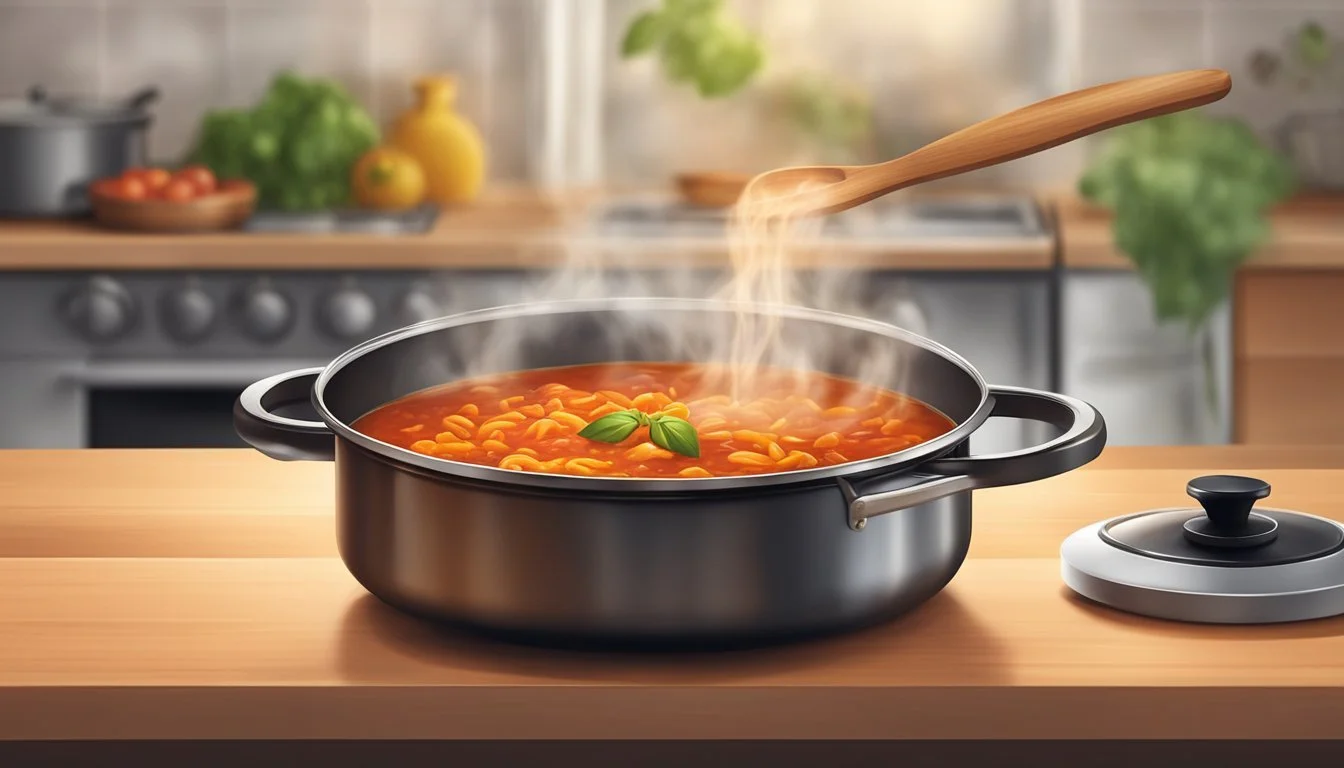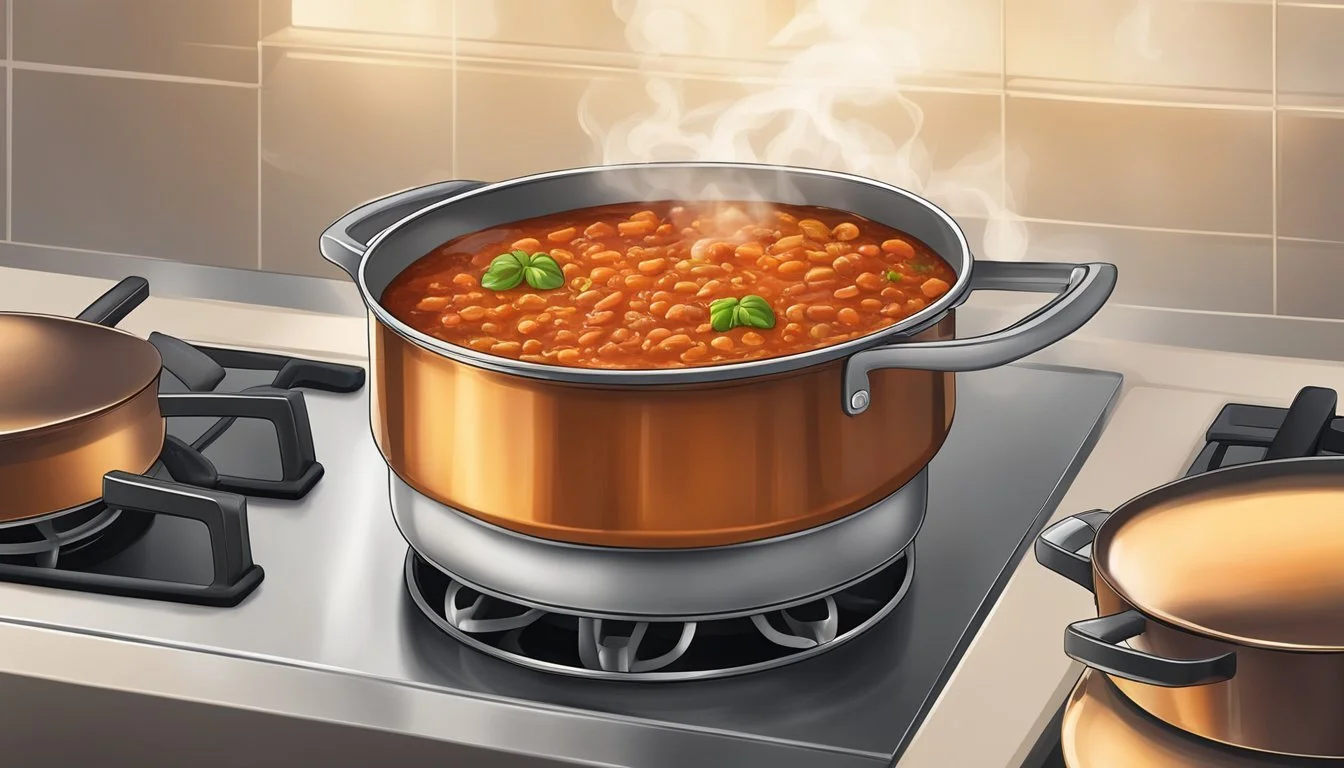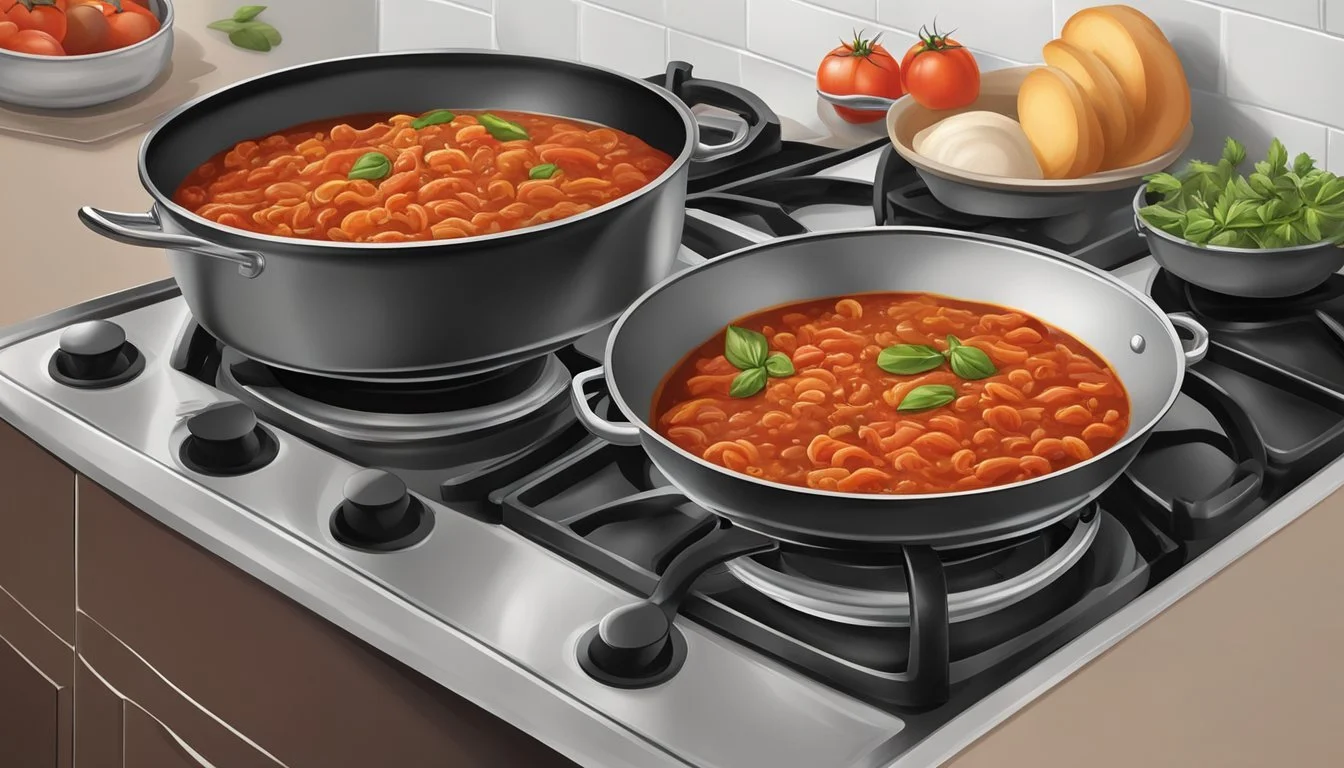Best Way to Reheat Bolognese Sauce
Preserving the Rich Flavor
Bolognese sauce, with its rich and complex flavors, is a staple in Italian cuisine known for its slow-cooked layers of taste. The blend of tomatoes, meat, and herbs develops over time, making the sauce even more delectable after it has settled in the refrigerator. Yet, when it comes to reheating, the challenge lies in warming up the sauce without diminishing its depth of flavor. Reheating bolognese sauce requires gentle care to ensure that the savory taste and silky texture are preserved, keeping the sauce just as enjoyable as when it was first prepared.
To maintain the integrity of bolognese sauce during the reheating process, one must consider the method that will evenly distribute heat without overcooking the ingredients. Techniques vary from the stovetop to the oven or even utilizing a microwave, each with its own merits. It is important to select a method that will not only heat the sauce thoroughly but also enhance its existing flavors and ensure that the sauce remains succulent, avoiding dryness or separation.
Awareness of the subtleties involved in warming up bolognese sauce is crucial. Whether one is serving the sauce over freshly cooked pasta (What wine goes well with pasta?) or as a component of a layered dish like lasagna, the objective remains the same: to revive the sauce to its optimal temperature and consistency. This ensures that each spoonful is as rich and inviting as the original dish, delivering a culinary experience that pays homage to the traditional Italian flavors that make bolognese sauce a beloved classic in home kitchens and restaurants alike.
Fundamentals of Reheating Bolognese Sauce
The key to perfectly reheating bolognese sauce lies in preserving its rich flavor and velvety texture. One must understand the science behind flavor development and employ proper reheating techniques to maintain the sauce's intended consistency.
Importance of Proper Reheating Techniques
Proper reheating techniques are essential for ensuring that bolognese sauce retains its depth of flavor and texture. Bolognese sauce should be reheated gently to avoid overcooking the ingredients which can lead to a loss of the nuanced flavors developed during the initial cooking process.
Microwave: For quick reheating, use a microwave-safe container, cover with a lid or damp paper towel, and heat in short intervals, stirring periodically.
Oven: Preheat the oven to 325°F (160°C) and spread the sauce in an oven-safe dish. Cover with foil or a lid and heat for 20-30 minutes, checking and stirring as needed.
Stove: Place the bolognese in a saucepan over medium-low heat. Stir frequently to ensure even heating and prevent scorching.
Utilizing these methods will not only warm the sauce but also help maintain its homogeneity.
Understanding Flavor Development
The flavors in bolognese sauce are a complex blend that develops over time, starting with the initial browning of meat and building with the addition of tomatoes, herbs, and spices. Reheating should respect this development by preserving the aromatic qualities and the savory umami character.
Aromatic Preservation: Slow, gentle reheating helps retain the aromatic components that could be lost with high heat.
Umami Enhancement: Heating at a controlled temperature allows umami flavors to remain prominent, which are essential for the rich taste associated with bolognese.
Texture and Consistency: Preservation of the sauce's consistency is achieved by avoiding overcooking, which can denature proteins in the meat and lead to a gritty texture.
By carefully managing the reheating process, one can ensure that the full-bodied flavor and smooth consistency of bolognese sauce is as close as possible to its freshly made state.
Pre-Reheating Tips
Before reheating bolognese sauce, it's essential to consider how it has been stored. Proper storage methods can maintain the sauce's rich flavor and safe consumption.
Storing Techniques for Bolognese Sauce
Refrigeration: To refrigerate leftover bolognese sauce, one should make use of airtight containers to prevent exposure to air and other contaminants. It's advised to consume refrigerated sauce within three to four days to ensure the best quality and flavor.
Containers Matter: For optimum freshness, storage in glass containers may be preferred over plastic, as they don't harbor odors or stains and can also be easier to clean.
Freezing and Thawing Bolognese Sauce
Freezing: When freezing bolognese sauce, leaving adequate headspace in the container is crucial to allow for expansion. Frozen bolognese sauce can last for up to three months without significant loss of flavor.
Do Don't Cool before freezing Freeze in large batches Label with a date Refreeze after thawing
Thawing: For best results, one should thaw frozen bolognese sauce in the refrigerator for several hours or overnight. This gradual thawing helps preserve the sauce's texture and flavor integrity, as opposed to a quick microwave defrost which could affect its quality.
Choosing the Right Reheating Method
Proper reheating is crucial to ensuring that Bolognese sauce retains its rich flavors and textures. Understanding the subtleties of different methods can greatly impact the outcome.
Stovetop Method
This traditional approach favors control and even heating. For the stovetop method, one should use a saucepan and add a small amount of olive oil or butter to prevent sticking. They should reheat the sauce over low heat, adding a few tablespoons of water or stock to loosen the sauce if necessary. It's vital to stir occasionally to maintain even heat distribution and prevent scorching.
Oven Method
Using an oven-safe dish, the user should preheat the oven to 350°F (175°C). The sauce must be placed in the dish and covered with a lid or aluminum foil to retain moisture and to let the sauce steam as it reheats. This method typically takes around 20-30 minutes and requires occasional stirring to ensure that flavors remain consistent throughout.
Microwave Method
For a quick option, the microwave can be used effectively with proper technique. The sauce should be placed into a microwave-safe dish, and they should cover it with a microwave-safe lid or a damp paper towel to promote even steam distribution and prevent drying. They should reheat in intervals, stirring between each to avoid overheating or uneven temperatures.
Step-by-Step Guides
When reheating spaghetti bolognese or its sauce, the method chosen can greatly impact the end result. It is crucial to keep the dish moist, retain its flavors, and ensure it is heated through without overcooking.
Reheating Spaghetti Bolognese on the Stove
Ingredients Needed: Leftover spaghetti bolognese, a skillet, olive oil (optional), pasta water or white wine (optional).
Step 1: Place a skillet on the stove and set to medium-high heat. If desired, add a little olive oil.
Step 2: Add the spaghetti bolognese into the skillet and stir occasionally to distribute the heat evenly.
Step 3: For added moisture, one can add a few tablespoons of pasta water or white wine.
Step 4: Cover the skillet partially with a lid and let it simmer on low heat for about 3-5 minutes.
Step 5: Remove the lid and let it cook for a few more minutes until completely heated through.
Warming Bolognese Sauce in the Oven
Ingredients Needed: Leftover bolognese sauce, an oven-safe dish, aluminum foil or lid.
Step 1: Preheat the oven to 325°F (160°C).
Step 2: Spread the bolognese sauce evenly in an oven-safe dish.
Step 3: Cover the dish with aluminum foil or an oven-safe lid to trap the moisture inside.
Step 4: Place in the oven to bake for about 20-30 minutes, ensuring it is heated thoroughly.
Microwaving Spaghetti Bolognese
Ingredients Needed: Leftover spaghetti bolognese, a microwave-safe container, water or stock.
Step 1: Place the spaghetti bolognese in a microwave-safe container.
Step 2: Add a tablespoon of water or stock to keep the pasta from drying out.
Step 3: Cover the container with a lid or plastic wrap suitable for microwaves.
Step 4: Heat on medium power in 30-second intervals, stirring at each pause to ensure even heating.
Step 5: Once warmed to satisfaction, let it stand for a minute before serving to distribute the heat uniformly.
Preserving and Enhancing Flavor
When reheating Bolognese sauce, the primary focus should be on maintaining its rich taste and depth. This section addresses ways to keep the sauce flavorful, ensure it retains moisture, and protect its seasoning integrity during the reheating process.
Adding Liquid to Prevent Dryness
To prevent the Bolognese sauce from becoming too dry, gently reintroduce moisture. A splash of water or broth can reincorporate steam into the sauce, contributing to a succulent texture. When using a microwave or stove:
Microwave: Add a tablespoon of water or broth, cover, and heat in brief intervals.
Stove: Stir in a small amount of liquid and reheat on a low simmer.
Maintaining Seasoning During Reheat
The seasoning can diminish during the reheating process. It's pivotal to taste the sauce and adjust the seasoning with salt, pepper, or herbs as needed. To preserve the original flavor profile:
Start with a pinch of salt or a grind of fresh pepper.
Incorporate fresh herbs in the last few minutes to refresh the taste.
Avoiding Overheating
Overheating can result in flavor loss and adversely affect the texture. Reheat the sauce slowly and gently:
Use medium heat on the stove, regularly stirring to distribute heat evenly.
If using an oven, opt for a moderate temperature (325°F-350°F), and check periodically, stirring to ensure even heating.
Adhering to these recommendations allows one to enhance and preserve the Bolognese sauce's flavor, assuring that it remains as delightful as when it was first prepared.
Common Mistakes to Avoid
When reheating bolognese sauce, it's essential to maintain the flavor while ensuring the safety and quality of the dish. Avoiding these common mistakes will lead to a better reheating experience.
Preventing Sauce from Sticking and Scorching
Reheating sauce requires careful attention to prevent sticking and scorching.
Stir Frequently: One should stir the sauce frequently to distribute heat evenly.
Medium Heat: Utilize a medium heat setting, as higher temperatures can cause the sauce to stick to the bottom of the pan and burn.
Temperature Control Pitfalls
Temperature plays a critical role in preserving the depth of flavor in bolognese sauce without reaching a point where it could result in spoilage.
Slow and Steady: Opt for a gentle reheat over a low to medium flame to warm the sauce.
Avoid High Heat: High temperatures can break down the molecular structure of the sauce, which compromises the complexity of its flavors.
Identifying When Leftovers Go Bad
Detecting spoilage is crucial to determine if the bolognese sauce is still safe to eat.
Color Changes: Watch for any significant changes in color, which may indicate spoilage.
Mold Growth: Any visible signs of mold mean the sauce should be discarded immediately.
Off Smell: Trust one's sense of smell - an off odor is a clear sign that the bolognese sauce has gone bad.
Storing Leftover Bolognese
Proper storage of leftover Bolognese is crucial to maintain its flavor and ensure safety upon reheating. They will enumerate the best ways to keep Bolognese sauce tasting fresh, whether one decides to refrigerate or freeze it.
Refrigeration Best Practices
When refrigerating leftover Bolognese sauce, one should place the sauce in an airtight container to prevent the invasion of other flavors and contaminants. Glass containers are often recommended for their non-porous nature, which keeps strong flavors contained and prevents staining. To ensure maximum freshness, Bolognese sauce should ideally be stored within two hours of cooking. Here's how to do it:
Cool the sauce to room temperature before sealing it to prevent condensation, which can lead to spoilage.
Ensure the container is sealed tightly to keep out bacteria and reduce exposure to air.
Leftover Bolognese sauce can be refrigerated for up to 3-4 days.
Freezing Techniques for Long-Term Storage
Freezing is a viable option for extending the shelf life of spaghetti Bolognese. If done correctly, it can preserve the quality of the sauce for several months. To freeze Bolognese sauce:
Pour the cooled Bolognese sauce into freezer-safe bags or containers. If using bags, lay them flat for space-efficient storage.
Label each container with the date to keep track of how long it's been stored.
When using bags, remove as much air as possible before sealing to prevent freezer burn.
A defrosted portion of Bolognese sauce should be consumed within 24 hours and should not be refrozen.
By following these recommendations, one can protect the integrity of leftover pasta sauce, ensuring it is just as enjoyable when reheated.
Pairings and Serving Suggestions
Once you've reheated your Bolognese sauce to perfection, pairing it with the right pasta and garnishes can dramatically enhance your dining experience. This section will guide you through choosing the best pasta and suggest the ideal cheese and toppings to complement the rich flavors of Bolognese sauce.
Choosing Suitable Pasta
For Bolognese sauce, one should select pasta that is robust enough to hold the hearty sauce. Spaghetti bolognese is a classic choice, offering a familiar texture and taste that marries well with the sauce. However, for those seeking to capture the sauce more effectively, broader pasta such as fettuccine or tagliatelle provides more surface area and is excellent at trapping the flavors of the sauce.
Recommended Cheese and Toppings
Cheese: To elevate the dish, a generous sprinkle of Parmesan cheese is recommended. The sharp, salty flavor of a finely grated cheese such as Parmesan complements the depth of the Bolognese sauce beautifully.
Cheese Type Characteristics Usage Parmesan Hard, granular cheese Grate over hot pasta Grana Padano Similar to Parmesan, less aged Use as a milder alternative Pecorino Romano Sheep's milk cheese, sharp For a more intense flavor
Toppings: Toppings should be minimal to allow the Bolognese sauce to shine. Fresh basil or parsley can add a splash of color and provide a fresh counterpoint to the rich sauce. A drizzle of high-quality olive oil can add a luxurious finish to the dish.
Additional Tips for Enhanced Flavor
When reheating bolognese sauce, the key to preserving and even enhancing its flavor lies in the careful addition of fresh ingredients and the strategic use of cooking liquids. These methods not only improve warmth but also bring out the richness of the sauce.
Incorporating Fresh Ingredients
Garlic and Onions: Freshly minced garlic or finely diced onions can be sautéed in olive oil before adding the bolognese sauce to the pan. This infuses the sauce with a vibrant aromatic base.
Tomatoes and Carrots: Adding a spoonful of fresh, diced tomatoes contributes to the acidity and sweetness, while grated carrots can introduce a subtle earthy note and additional sweetness that complements the meat.
Utilizing Cooking Liquids
Wine: A splash of red wine can be stirred in during the reheating process, deepening the sauce’s complexity with a note of fruitiness that is especially complimentary to tomato-based sauces. (What wine goes well with tomato-based sauces?)
Pasta Water: If the sauce is too thick, adding a bit of pasta water helps to achieve the desired consistency without compromising flavor, thanks to its starch content.
Meat Stock: For meat sauces, a bit of beef or chicken stock can be added to not only thin out the sauce if necessary but also to enrich its savory profile.
Bonus: Creative Ways to Repurpose Bolognese
When it comes to reinventing a classic Italian dish, bolognese sauce offers a plethora of possibilities. These innovative twists on traditional uses will ensure that leftover bolognese is anything but mundane.
Innovative Bolognese-Inspired Dishes
Spaghetti Pie: A comfort food marvel, spaghetti pie combines leftover bolognese sauce with pasta, beaten eggs, and cheese, baked until golden and sliceable.
Bolognese Stuffed Peppers: Hollowed bell peppers filled with flavorful bolognese sauce, topped with cheese, and oven-baked, make for a nutritious and satisfying meal.
Shepherd's Pie with a Twist: Layer a deep baking dish with bolognese as the base, followed by a layer of creamy mashed potatoes, and gratinate under the broiler.
Bolognese Quesadillas: Spread bolognese sauce between tortillas, sprinkle with mozzarella, and pan-grill until the exterior is crispy and the interior is sumptuously molten.
Bolognese Arancini: Mix bolognese with rice, shape into balls, coat in breadcrumbs, and fry to create a crispy outside with a rich, savory center.
Savory Bolognese Muffins: Infuse your favorite savory muffin recipe with bolognese sauce for a quick grab-and-go snack that's full of flavor.
Conclusion
When reheating Bolognese sauce, the goal is to preserve its rich flavors and achieve the desired temperature without altering its consistency or taste. Microwaving in a covered container with a damp paper towel on top can retain moisture efficiently, typically performed in short intervals of 90 seconds with stirring in between. Oven reheating at a moderate temperature, like 325°F, in an evenly spread, covered oven-safe dish for 20-30 minutes, is an alternative method that gently warms the sauce.
For Bolognese combined with spaghetti, a skillet over medium-high heat can distribute heat evenly. A dash of pasta water or white wine during the reheating can keep the Bolognese moist and add an extra dimension of flavor. Those preferring an oven approach for pasta and sauce combined, may cover the dish with a foil and heat at 350°F for about 15 minutes.
Tips for optimal results:
Stir the sauce periodically to ensure even heating.
Add a small quantity of liquid (e.g., water, stock, or wine) to avoid drying out.
Avoid overheating to prevent loss of flavor and texture.








